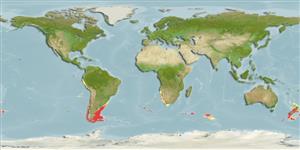Asteroidea |
Spinulosida |
Echinasteridae
Environment: milieu / climate zone / djupintervall / distribution range
Ekologi
; djupintervall 0 - 430 m (Ref. 87801). Temperate
Southeast Pacific, South Atlantic and Antarctic.
Length at first maturity / Size / Weight / Age
Könsmognad: Lm ? range ? - ? cm
It is found on coarse sand, shell, stones, pebbles and rock from the intertidal to a depth of 430 m (Ref. 87801).
Life cycle and mating behavior
Könsmognad | Reproduktion | Lek | Eggs | Fecundity | Larvae
Members of the class Asteroidea exhibit both asexual (regeneration and clonal) and sexual (gonochoric) means of reproduction. Life cycle: Embryos hatch into planktonic larvae and later metamorphose into pentamorous juveniles which develop into young sea stars with stubby arms.
Häussermann, V. and G. Försterra 2009 Marine benthic fauna of Chilean Patagonia. Santiago, Nature in Focus. 1000 p. (Ref. 87801)
IUCN Red List Status
(Ref. 130435: Version 2025-1)
CITES status (Ref. 108899)
Not Evaluated
Not Evaluated
Threat to humans
Harmless
Human uses
| FishSource |
Verktyg
Ytterligare information
Trophic EcologyFood items (preys)
Födosammansättning
Födointag
Predatorer
Population dynamicsTillväxtMax. ages / sizesLength-weight rel.Length-length rel.Length-frequenciesMass conversionAbundans PhysiologySyreförbrukning
Human RelatedStamps, coins, misc.
Internet-källor
Estimates based on models
Preferred temperature
(Ref.
115969): 3.8 - 14, mean 7.1 (based on 463 cells).
